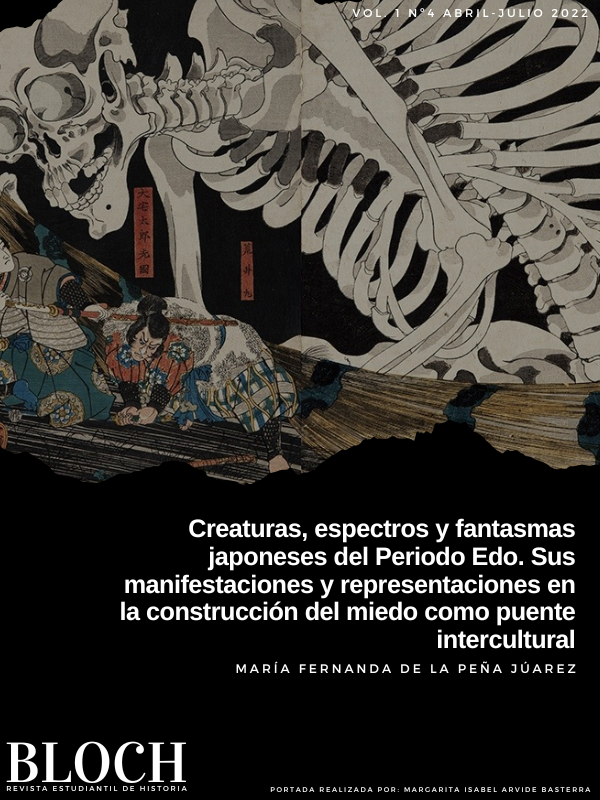Japanese Creatures, Spectrums, And Ghosts Of The Edo Period. Its Manifestations And Representations In The Construction Of Fear As An Intercultural Bridge

Published 2022-04-30
Keywords
- Cultural history; Japanese legends and mythology; yōkai; yūrei; cinema.
How to Cite
Copyright (c) 2022 María Fernada De la Peña Júarez

This work is licensed under a Creative Commons Attribution 4.0 International License.
Abstract
In Japanese culture there is a wide variety of creatures whose existence explains the way in which fear is built and visualized; these beings and the stories generated around them have aroused the interest of other nations, which have taken up these figures and stories adapting them to their own ways of representing visuality and manifesting it with readjustments of ancient Japanese stories that emerged mostly in the period Edo.
Downloads
References
- Foster, Michael Dylan. The book of yokai. Mysterious creatures of Japanese Folklore. California: University of California Press, 2015.
- Hearn, Lafcadio. Fantasmas de la China y del Japón. Sevilla; Espuela de Plata, 2011.
- Hearn, Lafcadio. Japón. Un intento de interpretación. Gijón: Satori Ediciones, 2013.
- Mitford, Algernon Bertram. Tales of Old Japan. Folklore, fairy tales, ghost stories and legends of the samurai. New York: Dover Publications, 2005.
- Pérez Riobó, Andres y Chida, Chiyo. Yokai. Monstruos y fantasmas en Japón. Gijón: Satori Ediciones, 2013.
- Ramírez, Alberto, Kaiki. Cuentos de terror y locura. Madrid: Quaterni, 2017.
- Reider, Noriko T. “The Appeal of «Kaidan». Tales of the Strange”. Asian Folklore Studies 59, no. 2 (2000), 265 – 283. https://www.jstor.org/stable/1178918.
- Reider, Noriko T. “The Emergence of «Kaidan-shū». The Collection of Tales of the Strange and Mysterious in the Edo Period”. Asian Folklore Studies 60, no. 1 (2001), 79 – 99. https://www.jstor.org/stable/1178699.
- Rubio, Carlos, ed. Kojiki. Crónicas de antiguos hechos de Japón. Madrid: Editorial Trotta, 2008.
- Shimazaki, Satoko. “The End of the “World”: Tsuruya Nanboku IV´s Female Ghost´s and Late-Tokugawa Kabuki”. Monumenta Niponica 66, no. 2 (2011), 209 – 246. https://www.jstor.org/stable/41686466.
- Ono, Sokyo. Sintoísmo. La vía de los kami. Gijón: Satori Ediciones, 2017.
- Thornber, Karen. Japanese Tales from the Times Past. Stories of Fantasy and Folklore from the Konjaku Monogatari Shu. Singapore: Tuttle Publishing, 2015.
- Wee, Valerie. “Visual Aesthetics and Ways of Seeing: Comparing “Ringu” and “The Ring””. Cinema Journal 50, no. 2 (2011), 41 – 60. https://www.jstor.org/stable/41240693.
- Yamamoto, Noriko. Something Wicked from Japan. Ghosts, Demons & Yōkai in Ukiyo-e Masterpieces. Tokyo: PIE Inernational, 2016.
- Yanagita, Kunio. Mitos populares de Japón. Leyendas de Tōno. Madrid: Quaterni, 2013.
- Yasui, Manami, “Imagining the Spirits of Deceased Pregnant Women: An Analysis of Illustrations of Ubume in Early Modern Japan”. Japan Review, no. 32 (2020), 91 – 112. https://www.jstor.org/stable/27009002.
- Yusa, Michiko. Religiones de Japón. Madrid: Ediciones Akal, 2005
